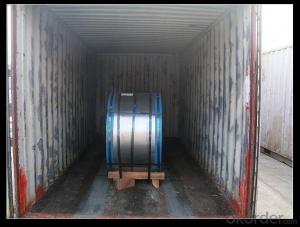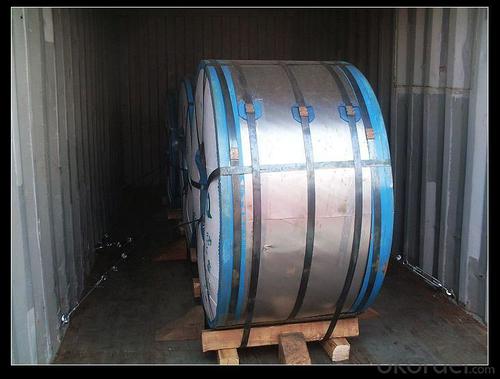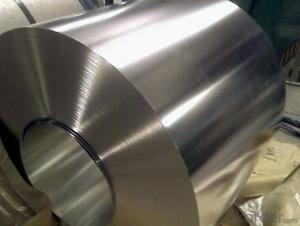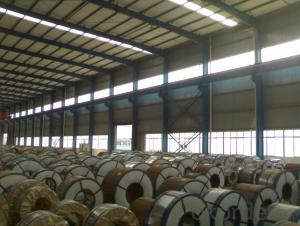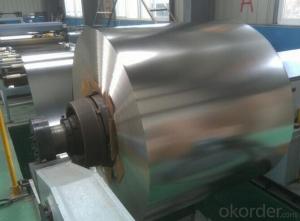Electrolytic Tinplate in Coils for Foods and Chemical Cans Packing
- Loading Port:
- Tianjin
- Payment Terms:
- TT OR LC
- Min Order Qty:
- 25 m.t
- Supply Capability:
- 7000 m.t/month
OKorder Service Pledge
OKorder Financial Service
You Might Also Like
1.Structure of Electrolytic Tinplate in Coils for Foods and Chemical Cans Packing Description
Electrolytic Tin Plate Coils and Sheets for Foods Metal Packaging, is one thin steel sheet with a coating of tin applied by electrolytic deposition. Tinplate made by this process is essentially a sandwich in which the central core is strip steel. This core is cleaned in a pickling solution and then fed through tanks containing electrolyte, where tin is deposited on both sides. As the strip passes between high-frequency electric induction coils, it is heated so that the tin coating melts and flows to form a lustrous coat.
2.Main Features of the Electrolytic Tinplate in Coils for Foods and Chemical Cans Packing
Appearance – Electrolytic Tin Plate is characterized by its beautiful metallic luster. Products with various kinds of surface roughness are produced by selecting the surface finish of the substrate steel sheet.
Paintability and printability – Electrolytic Tin Plates have excellent paintability and printability. Printing is beautifully finished using various lacquers and inks.
Formability and strength – Electrolytic Tin Plates have got very good formability and strength. By selecting a proper temper grade, appropriate formability is obtained for different applications as well as the required strength after forming.
Corrosion resistance – Tinplate has got good corrosion resistance. By selecting a proper coating weight, appropriate corrosion resistance is obtained against container contents. Coated items should meet 24 hour 5 % salt spray requirement.
Solderability and weldability – Electrolytic Tin Plates can be joined both by soldering or welding. These properties of tinplate are used for making various types of cans.
Hygienic – Tin coating provides good and non toxic barrier properties to protect food products from impurities, bacteria, moisture, light and odours.
Safe – Tinplate being low weight and high strength makes food cans easy to ship and transport.
Eco friendly – Tinplate offers 100 % recyclability.
Tin is not good for low temperature applications since it changes structure and loses adhesion when exposed to temperatures below – 40 deg C.
3.Electrolytic Tinplate in Coils for Foods and Chemical Cans Packing Images
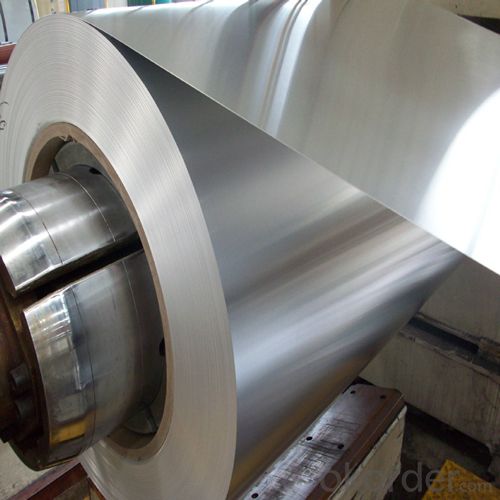

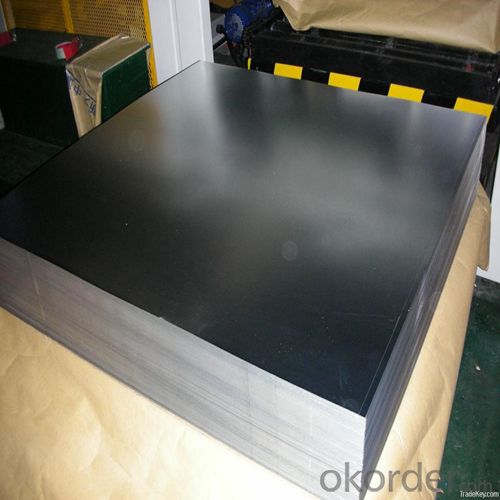
4.Electrolytic Tinplate in Coils for Foods and Chemical Cans Packing Specification
Standard | ISO 11949 -1995, GB/T2520-2000,JIS G3303,ASTM A623, BS EN 10202
|
Material | MR,SPCC |
Thickness | 0.15mm - 0.50mm |
Width | 600mm -1150mm |
Temper | T1-T5 |
Annealing | BA & CA |
Coil Inner Diameter | 508mm |
Weight | 6-10 tons/coil 1~1.7 tons/sheets bundle |
Passivation | 311 |
Oil | DOS |
Surface | Finish,bright,stone,matte,silver |
5.FAQ of Electrolytic Tinplate in Coils for Foods and Chemical Cans Packing
- How are the Electrolytic Tin Plates specified?
The Electrolytic Tin Plates are specified as per the steel base, extent of tempering, the coating weight, annealing method and the surface finish.
- How many types there are for base steels?
The base steels are of three types: Type MR, L, D
- Q: What are some common tinplate products?
- Some common tinplate products include food and beverage cans, aerosol cans, paint cans, metal packaging for cosmetics and personal care products, and metal containers for various industrial applications.
- Q: How does tinplate perform in terms of impact resistance?
- Tinplate generally exhibits excellent impact resistance due to its sturdy and tough nature. It can withstand moderate to heavy impacts without deforming or breaking easily, making it a reliable choice for packaging and other applications requiring durability.
- Q: How does tinplate contribute to the preservation of aerosol products?
- Tinplate contributes to the preservation of aerosol products by providing a durable and protective container that helps prevent the penetration of moisture, air, and light which can degrade the quality and effectiveness of the product. Additionally, tinplate containers are resistant to corrosion, ensuring the longevity and integrity of aerosol products.
- Q: How does tinplate contribute to the reduction of plastic waste?
- Tinplate contributes to the reduction of plastic waste by providing a sustainable alternative packaging option. Tinplate cans can be recycled indefinitely, reducing the need for single-use plastic containers. Additionally, tinplate cans are lightweight, which helps in reducing transportation emissions.
- Q: Can tinplate be used for beverage cans?
- Yes, tinplate can be used for beverage cans. Tinplate, which is a thin sheet of steel coated with a layer of tin, provides excellent protection against corrosion and is commonly used in the production of beverage cans.
- Q: How is tinplate tested for quality assurance?
- Tinplate is tested for quality assurance through various methods including visual inspection, chemical analysis, mechanical testing, and coating thickness measurement.
- Q: What are the common forms of corrosion that affect tinplate?
- Tinplate commonly experiences three forms of corrosion: uniform corrosion, pitting corrosion, and tin whisker growth. Uniform corrosion occurs evenly across the surface, leading to a thinning of the tin coating. Pitting corrosion, on the other hand, creates localized holes or pits, compromising the integrity of the tinplate. Lastly, tin whisker growth involves the formation of tiny, crystalline structures that can lead to short-circuits or other electrical issues.
- Q: How is tinplate formed into different shapes?
- Tinplate is formed into different shapes through a process called metal stamping or deep drawing. The tinplate sheet is fed into a machine where a die and punch press it into the desired shape. The pressure exerted by the punch forces the tinplate to conform to the shape of the die, resulting in the formation of various shapes such as cans, containers, or lids.
- Q: Can tinplate be used for industrial or automotive applications?
- Yes, tinplate can be used for industrial or automotive applications. Tinplate is a type of steel coated with a thin layer of tin, which provides excellent corrosion resistance and durability. This makes it suitable for various industrial and automotive purposes, such as manufacturing cans, containers, packaging, electrical components, and automotive parts. Its versatility and protective properties make tinplate a preferred choice in these industries.
- Q: How does tinplate perform in terms of heat transfer?
- Tinplate performs poorly in terms of heat transfer compared to other materials.
Send your message to us
Electrolytic Tinplate in Coils for Foods and Chemical Cans Packing
- Loading Port:
- Tianjin
- Payment Terms:
- TT OR LC
- Min Order Qty:
- 25 m.t
- Supply Capability:
- 7000 m.t/month
OKorder Service Pledge
OKorder Financial Service
Similar products
Hot products
Hot Searches
Related keywords


